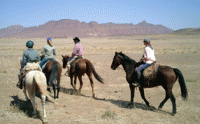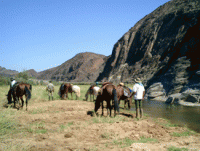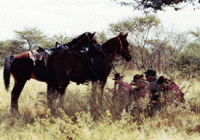Africa- Namib Desert on Horseback





By Kerry Scott
My trek across the Namib Desert begins in Namibia's capital of Windhoek. It is a very cosmopolitan city, yet still lets me know I am in Africa. If you left something at home that you really needed, you could probably find it in Windhoek.
Once I leave the city, it is instantaneously apparent how wild and wide open this country is. Namibia is the size of France and Germany put together, but only has 1.2 million residents. I have heard it is even possible to ride for days without seeing another human being apart from those in your party.
Riding into the Desert
Here we ride in western saddles. Even those who ride English at home soon find that western is the way to go on these long treks through the desert. I am carrying my personal water supply, lunch, and other personal items, including a camera. These are far easier to secure to a western rig.
I am high here, with the high desert plateaus in the Namib Desert beginning up around 5,000 feet. The altitude, together with the clear desert air and mostly cloudless sky, makes the sun merciless. I suggest protecting your skin with long sleeves and a broad-brimmed hat. High SPF sunscreens are also helpful. That said, the complete lack of humidity makes even the hottest day here bearable.
The broad expanses, varied landscapes, varieties of flora and fauna make the Namib heaven for photographers. Film and memory cards are essential in order to bring this memorable landscape home. The lack of wall outlets in Namibia requires one to bring plenty of batteries along.
While we are riding from camp to camp, the staff breaks each camp site down and moves it to the next night's stop in 4WD vehicles. Some days we will be met for lunch as well. Other days, there will be no way for the trucks to meet the group until night , so lunch is carried with us. When we do meet up with them at night at camp, there are cool, refreshing drinks and a hot shower waiting for us while supper cooks on an open fire. By the time our horses have been given food, water and a little grooming, our supper is ready and we are hungry.
Camping out in the Namib Desert
Our first night in the desert is astounding. In this clear air, with no light pollution to spoil the view, we can see more stars than we thought existed. In these skies, we can even see satellites moving across the night sky and meteor showers are a regular occurrence. Though dome tents are available, most of us choose to sleep on a cot under the stars. There are virtually no insects here to spoil our sleep. There is also little chance of rain during trekking season.
In terms of wildlife, people have been known to see various species of antelope (there are twenty or so different species here), and possibly desert elephant and rhino. Cheetah and leopard thrive here, but try to stay clear of man. You should consider yourself fortunate if you see one of these secretive creatures. Lions are making a comeback in this part of Namibia, but their numbers are still low, and they too will try to stay out of the way. Lots and lots of birds not found in the U.S. or Europe are found here. Bird watchers can add a number of interesting species to their life lists here.
Plant life includes various kinds of acacia trees and other kinds of trees, almost all of which bear some kind of thorns. We were told to be careful when looking for a bit of shade or we might lose a bit of blood!
The Namib is one of the oldest deserts in the world, but it is really three distinct deserts. The high plateau desert gets a decent amount of rainfall and has a lot of vegetation, and varied topography. To cross this part of the desert one will often follow dry river beds. The gravel plain desert is flat as far as the eye can see, broken only by the occasional “inselberg" or island mountain. This is the home of the Welwitchia plant, one of the oldest and most interesting on earth. As you near the coast you find the dune desert, wind-driven and constantly on the move. The dunes here are among the highest on earth, and in some places run right up to the sea.
The Skeleton Coast
The first sign that we are approaching the coast is the fog and the slow but sure decrease in temperature. Though there is still very little rainfall, the fog which rolls in off the South Atlantic, provides sufficient moisture for the plants and animals who have adapted to this climate to survive. This is the Skeleton Coast, so called because of the skeletons of ships that have run aground on these shores over the last couple of centuries.
Arab, Lipizzaner, Saddlebred, Hanoverian-cross, Boerperd, Thoroughbred crosses are among the breeds of horse you may ride in Namib. The common denominator is that they are all hardy, experienced desert horses. They are tough and good natured. With enough food and water, and a little grooming, they will get you across the desert in one piece.
Fellow riders may be a mix of Americans, Europeans, and Southern Africans. English is the language generally spoken here, although German and Afrikaans will pop up now and then. You should be an experienced rider to do these trips. You'll be covering a lot of ground, so expect some long, fast runs when the terrain and surface allow for it. This is no dude-ranch trail ride. This is the real deal.
Once reaching the coast, we find ourselves in the oasis that is the city of Swakopmund. We were struck by the incongruity of this former German outpost rising out of nowhere, where the desert meets the ocean. Here we have the chance for one more ride, this one on the beach, bareback if we wish. We also find real beds and restaurant food; the perfect place to ease back into civilization.
From Swakopmund, you'll fly or drive back to Windhoek and eventually home. If you are like us, you may leave the Namib, but a piece of the Namib will always be with you. Once Africa gets in your blood, you'll be back.
About the Author
Kerry Scott is a seasoned outdoorsman and African traveler. As a graduate of the North Carolina Outward Bound School and a retired Army officer, Scott has traveled extensively around the world. His 28 years in the military included tours of duty in Austria, Ethiopia, Rwanda, and Liberia. In addition, Kerry has traveled extensively in Southern Africa, driving support to several long-distance treks across the Namib and the Kalahari deserts. Scott is now the President of Narrow Gate Trekking, which leads horseback riding trips through Africa. Though Kerry Scott and his wife live on the family farm in the heart of Virginia, their hearts have belonged in Africa since first traveling there in 1996. Scott owns four Lipizzan horses and a director of the United States Lipizzan Registry. For more information on treks in Africa Visit Narrow Gate Trekking.
Learn about equestrian vacations and book a trip to ride in Namibia at EquitrekkingTravel.com.




